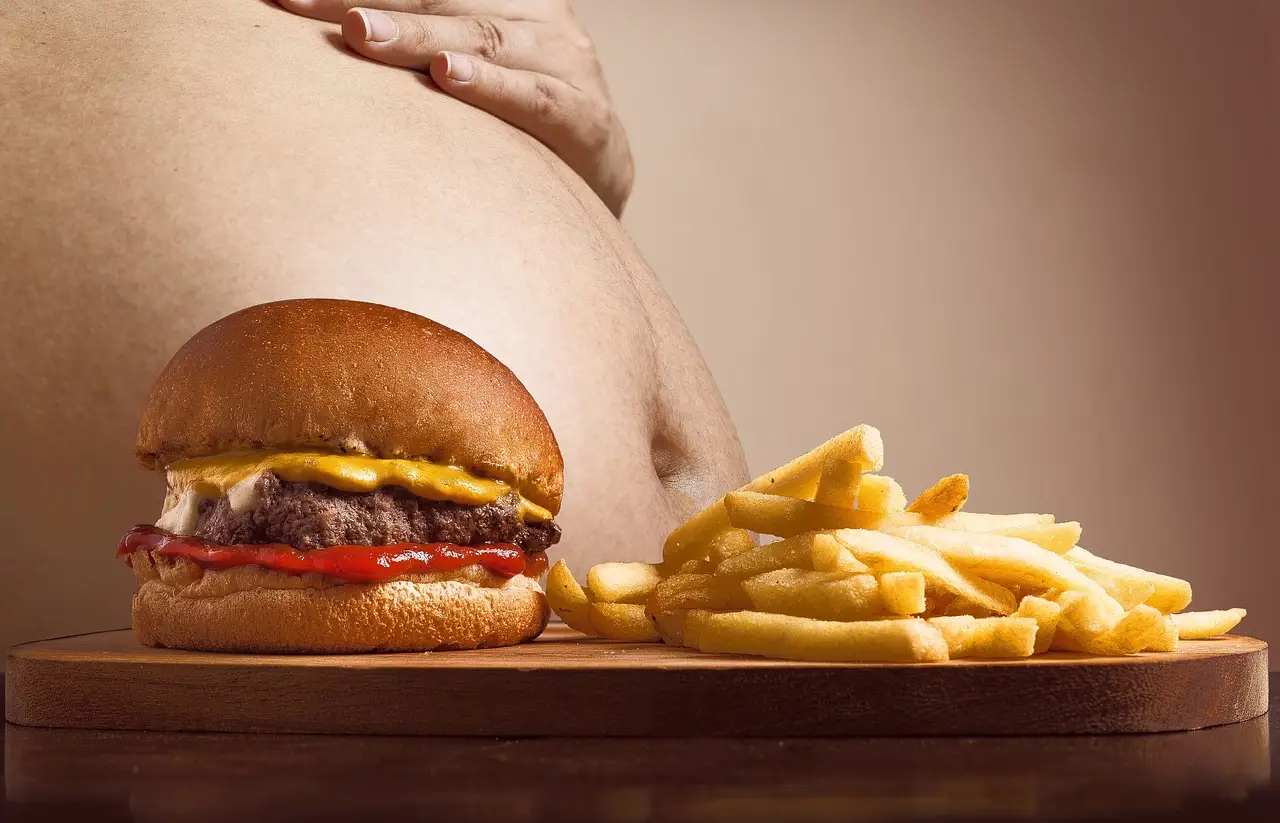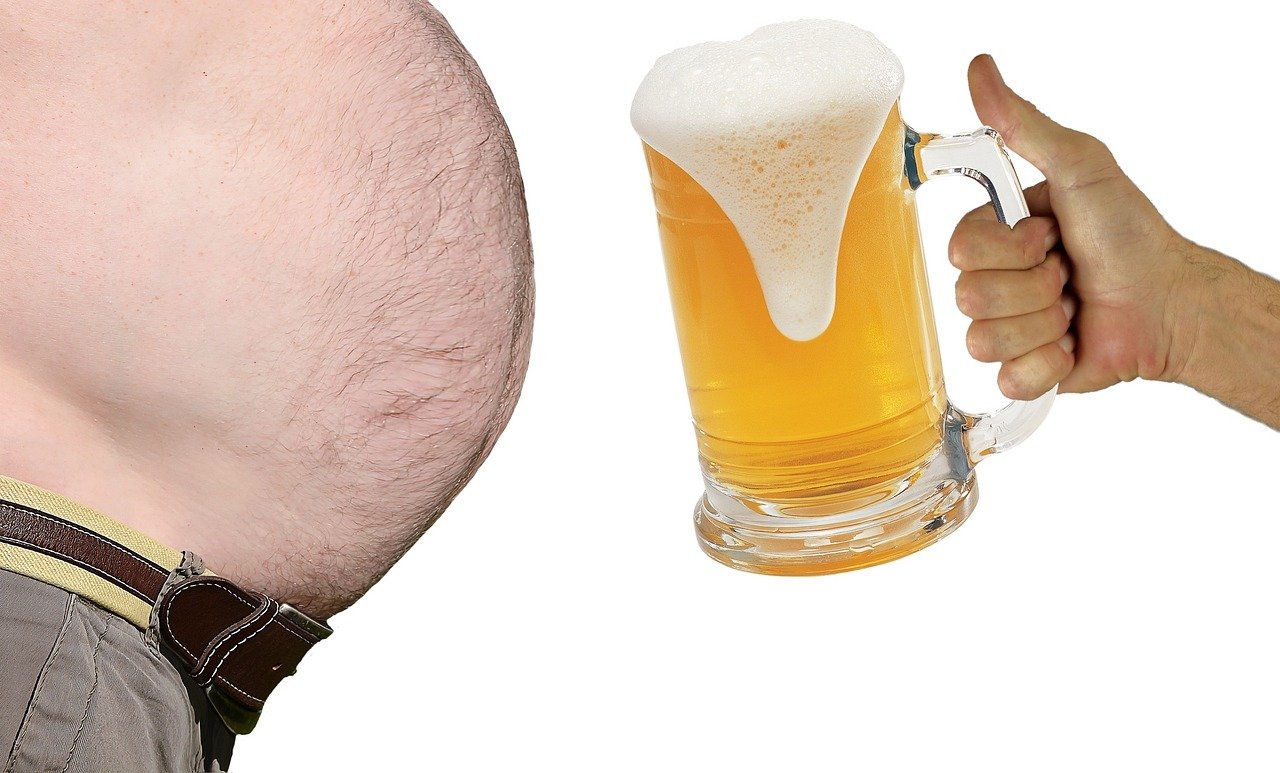Did you know that visceral fat (the dangerous kind around your organs) increases your risk of heart disease by 44%?
Yikes! But don’t panic – we’ve got your back.
Losing belly fat isn’t just about looking good in swimwear; it’s about taking charge of your health.
Buckle up, because we’re about to dive into the nitty-gritty of melting away that stubborn tummy fat!
Understanding Belly Fat: Not All Fat is Created Equal.
Types of Belly Fat: Subcutaneous vs. Visceral.
When it comes to belly fat, it’s essential to understand the two types: subcutaneous fat and visceral fat.
Subcutaneous fat is the fat that sits just under your skin, the kind you can pinch.
While it can be aesthetically displeasing, it’s less harmful than visceral fat.
Visceral fat, on the other hand, surrounds your internal organs, like the liver and intestines, and poses serious health risks.
This deep, hidden fat contributes to a higher risk of heart disease, type 2 diabetes, and even certain cancers.
Health Risks Associated with Excess Belly Fat
Carrying excess visceral fat is linked to metabolic syndrome, a cluster of conditions that increase your chances of heart disease, stroke, and diabetes.
Elevated visceral fat levels also raise cortisol, the stress hormone, which further promotes fat accumulation in the abdomen.
This creates a vicious cycle, as high cortisol levels can also lead to insulin resistance, making it harder to lose belly fat.
Additionally, visceral fat triggers chronic inflammation, which damages the body over time, leading to conditions such as heart disease and abdominal obesity.
Factors Contributing to Belly Fat Accumulation

Several factors contribute to the accumulation of belly fat:
- Diet: High consumption of processed foods, sugars, and unhealthy fats can lead to an increase in belly fat.
- Stress: Elevated stress levels lead to higher cortisol production, which encourages fat storage in the abdominal area.
- Lack of Physical Activity: A sedentary lifestyle can slow down metabolic rate, making it easier to accumulate fat, particularly around the midsection.
- Sleep: Poor sleep quality is linked to hormonal imbalances, particularly those regulating hunger and fat storage.
- Age and Genetics: As you age, your metabolism slows down, and some individuals are genetically predisposed to store more fat in their abdomen.
The Role of Diet in Losing Belly Fat
Calorie Deficit: The Foundation of Fat Loss
The key to losing belly fat—and any fat—is to create a calorie deficit, where you burn more calories than you consume.
This forces the body to tap into its fat reserves, including those in the belly.
A moderate, sustainable calorie deficit is crucial for preserving lean body mass and ensuring that the fat loss is gradual, which is more likely to be permanent.
Using a calorie tracking app can help you manage this more effectively.
Importance of Protein in Preserving Muscle Mass.
Consuming adequate amounts of protein is essential in any fat-loss journey.
Protein helps preserve muscle mass while losing fat, which is vital since muscle burns more calories at rest than fat.
High-protein diets also help increase feelings of satiety, preventing overeating and aiding in the maintenance of lean muscle during a calorie deficit.
Fiber-Rich Foods for Satiety and Gut Health.
Fiber is your friend when trying to lose belly fat.
High-fiber foods promote satiety, helping you feel full for longer and reducing overall calorie intake.
They also support gut health, which is linked to weight management.
Soluble fiber in particular has been shown to help reduce visceral fat.
Foods like oats, beans, fruits, and vegetables are excellent sources of fiber to incorporate into your diet.
Healthy Fats and Their Role in Hormone Balance.
Contrary to popular belief, not all fats are bad.
Healthy fats, such as those found in avocados, nuts, seeds, and olive oil, are essential for hormone balance, especially for managing cortisol levels and improving insulin sensitivity.
These fats also help keep you full and satisfied, reducing the likelihood of overeating.
Incorporating omega-3 fatty acids, in particular, can help lower inflammation and promote fat loss, especially around the belly.
Exercise Strategies to Target Belly Fat
High-Intensity Interval Training (HIIT) for Fat Burning
When it comes to maximizing fat loss, High-Intensity Interval Training (HIIT) is a game-changer.
HIIT workouts alternate between intense bursts of activity and periods of rest or lower-intensity exercise, leading to a greater calorie burn in a shorter amount of time.
HIIT is particularly effective at burning visceral fat, which is harder to target through moderate, steady-state exercises.
It also has a prolonged afterburn effect, meaning your body continues to burn calories even after your workout ends.
Strength Training to Boost Metabolism
While cardio is important, strength training is equally vital for losing belly fat.
Building lean muscle mass through resistance exercises helps increase your resting metabolic rate, meaning you burn more calories throughout the day, even when you’re not working out.
Incorporating compound movements like squats, deadlifts, and bench presses engages large muscle groups, boosting overall fat loss.
The Myth of Spot Reduction and Why Overall Body Fat Matters
One of the biggest misconceptions in fitness is the idea of spot reduction, or the ability to lose fat from a specific part of the body through targeted exercises.
Unfortunately, it’s not possible to lose fat from just one area, like the belly, without reducing overall body fat.
To lose belly fat, you need to focus on total body fat reduction, which comes from a combination of diet, exercise, and lifestyle changes.
Core exercises like planks and Russian twists are great for building strength and definition but won’t directly burn belly fat without addressing overall fat loss.
Importance of Consistency in Your Workout Routine
The most effective fat-loss routine is the one you can stick to. Consistency is key when it comes to both diet and exercise.
To achieve lasting results, aim for a combination of cardio, strength training, and flexibility exercises throughout the week.
Mixing up your routine also helps prevent burnout and keeps you motivated as you work toward your goal of losing belly fat.
Lifestyle Factors That Influence Belly Fat.
Sleep Quality and Its Impact on Weight Management
Sleep is often the unsung hero of weight loss.
Poor sleep quality can wreak havoc on your metabolism and hunger hormones, making it harder to shed belly fat.
When you don’t get enough sleep, your body produces more ghrelin, the hunger hormone, while reducing leptin, the hormone that signals fullness.
This combination makes you more likely to overeat, particularly craving high-calorie, high-sugar foods.
Moreover, chronic sleep deprivation can lead to insulin resistance, a key driver of visceral fat accumulation.
Prioritizing 7-9 hours of quality sleep each night can significantly enhance your fat loss efforts, particularly around the belly.
Stress Reduction Techniques to Lower Cortisol Levels
Chronic stress triggers the release of cortisol, a hormone that encourages the body to store fat, particularly around the abdomen.
High cortisol levels also increase cravings for comfort foods, often leading to overeating.
Incorporating stress-reduction techniques such as mindfulness, meditation, deep breathing exercises, and even yoga can help manage cortisol levels and prevent the accumulation of belly fat.
Finding ways to balance your emotional well-being can be just as important as diet and exercise when it comes to losing fat in the abdominal area.
Hydration and Its Role in Metabolism
Staying hydrated is crucial for maintaining a healthy metabolism.
Water aids in digestion, helps regulate body temperature, and supports the breakdown of fat cells through a process called lipolysis.
Inadequate hydration can slow down your metabolism and make it harder to lose weight, including belly fat.
Drinking enough water can also help reduce bloating, which can give your stomach a leaner appearance.
Aiming for at least 8-10 glasses of water a day is a simple yet effective way to support your body’s fat-burning processes.
The Effects of Alcohol on Belly Fat.

Alcohol can be a significant roadblock when it comes to losing belly fat.
Not only is alcohol high in empty calories, but it also impairs your body’s ability to burn fat.
When you consume alcohol, your body prioritizes metabolizing it over other nutrients, which slows down fat-burning processes.
Additionally, alcohol can increase your appetite and lower inhibitions, leading to overeating.
Frequent alcohol consumption is also linked to increased visceral fat, so cutting back on alcohol or opting for lower-calorie alternatives can help you reduce belly fat more effectively.
Hormones and Belly Fat: What You Need to Know.
Insulin Resistance and Its Relationship to Abdominal Fat
Insulin is a hormone that helps your cells absorb glucose (sugar) from your bloodstream.
However, when your body becomes insulin resistant, it stops responding effectively to insulin, causing excess glucose to remain in the bloodstream.
This leads to elevated blood sugar levels, which promote fat storage, particularly around the abdomen.
Over time, insulin resistance can lead to type 2 diabetes and other metabolic issues.
Managing insulin resistance through a balanced diet rich in fiber, protein, and healthy fats can help reduce abdominal fat and improve overall metabolic health.
Cortisol: The Stress Hormone That Promotes Belly Fat Storage
Cortisol is a hormone produced by your adrenal glands in response to stress.
While it plays an essential role in your body’s fight-or-flight response, chronic stress leads to consistently elevated cortisol levels, which can increase belly fat storage.
Cortisol promotes the accumulation of visceral fat, the type of fat that surrounds your internal organs and is linked to numerous health risks.
Reducing stress through activities like exercise, meditation, and adequate sleep can help keep cortisol levels in check and reduce abdominal fat over time.
Balancing Estrogen and Testosterone for Optimal Fat Loss
Hormonal imbalances, particularly in estrogen and testosterone, can significantly affect where your body stores fat.
For women, higher levels of estrogen can encourage fat storage in the hips, thighs, and abdomen, especially during perimenopause and menopause.
For men, lower levels of testosterone can lead to increased abdominal fat.
Maintaining a healthy balance of these hormones is key to promoting fat loss and preventing further fat accumulation.
Regular exercise, a healthy diet, and lifestyle changes can all contribute to healthier hormone levels, helping you lose belly fat more effectively.
Supplements and Their Effectiveness in Belly Fat Reduction
Green Tea Extract and Its Fat-Burning Properties
Green tea extract is a popular supplement touted for its fat-burning properties, particularly due to its high content of catechins, a type of antioxidant.
Studies suggest that EGCG (Epigallocatechin gallate), the primary catechin in green tea, may help boost metabolism and increase the body’s ability to burn fat, especially during exercise.
Regular consumption of green tea extract, along with a balanced diet and exercise routine, could slightly increase fat-burning capacity.
However, while it may help accelerate the process, green tea extract alone won’t lead to significant belly fat reduction without a holistic approach.
Probiotics for Gut Health and Potential Weight Loss
Your gut health plays a crucial role in many aspects of your overall health, including weight management.
Certain strains of probiotics, such as Lactobacillus gasseri, have been linked to reducing visceral fat and improving insulin sensitivity.
By maintaining a healthy balance of gut bacteria, probiotics can aid in digestion, reduce inflammation, and potentially influence fat storage.
While more research is needed, incorporating probiotics through supplements or foods like yogurt and kefir may support your belly fat reduction efforts by promoting a healthy gut environment.
Protein Supplements to Support Muscle Maintenance
Protein is vital for building and maintaining lean muscle mass, which can help boost your metabolism and reduce body fat, including belly fat.
Supplementing with protein powder, whether it’s whey, casein, or plant-based proteins, can help ensure you meet your daily protein needs, especially if you’re working out regularly.
Protein supplements can promote muscle recovery, curb appetite, and reduce hunger cravings, all of which are essential for sustainable fat loss.
Opting for a high-quality protein supplement may support your efforts to maintain muscle mass while losing fat, especially when combined with resistance training.
The Truth About “Fat-Burning” Supplements
While “fat-burning” supplements are widely marketed, their actual effectiveness is often exaggerated.
Most fat burners contain stimulants like caffeine or ingredients such as green tea extract, CLA (conjugated linoleic acid), and L-carnitine, which may slightly increase metabolism or promote fat oxidation.
However, the results from these supplements are typically modest at best.
True belly fat reduction requires a combination of caloric deficit, regular exercise, and consistent lifestyle changes.
It’s important to approach fat-burning supplements with skepticism, as they are not a replacement for sustainable habits.
Tracking Progress: Beyond the Scale.
Measuring Body Composition vs. Body Weight
When it comes to losing belly fat, focusing solely on the number on the scale can be misleading.
Body composition—the ratio of fat to lean muscle mass—is a much more accurate reflection of your progress.
You might be losing fat and gaining muscle, which can cause your weight to stay the same or even increase slightly, despite positive changes in your body.
Tools like body fat calipers, DEXA scans, or bioelectrical impedance scales can help you track your body composition over time, providing a clearer picture of your fat loss journey.
Using Progress Photos to Visualize Changes
Sometimes the scale won’t show progress, but your body will.
Taking progress photos is a powerful way to track changes in your appearance, especially when it comes to belly fat reduction.
By comparing photos taken from multiple angles every few weeks, you can visually see reductions in belly fat, muscle definition improvements, and overall body transformations.
Make sure to take the photos under consistent lighting, in the same outfit, and from the same distance for accurate comparisons.
Waist Circumference as a Key Indicator of Health
Tracking your waist circumference is a practical and straightforward way to measure belly fat loss.
Unlike subcutaneous fat (the fat beneath your skin), visceral fat wraps around your organs and poses greater health risks, such as heart disease and diabetes.
By measuring your waist circumference, you can monitor visceral fat levels and track improvements in your abdominal health.
Aim for a waist measurement below 35 inches for women and 40 inches for men to lower your risk of metabolic diseases.
The Importance of Non-Scale Victories
While body weight and composition are important, it’s equally vital to celebrate non-scale victories.
These can include feeling more energetic, improving your sleep quality, fitting into clothes more comfortably, or noticing a boost in self-confidence.
Focusing solely on the scale can be frustrating, as it doesn’t capture all the positive changes happening within your body.
Pay attention to improvements in your fitness levels, mental health, and overall well-being, as these are key indicators of long-term success.
Alright, fat-fighters, you’re now armed with the science-backed strategies to wage war on belly fat!
Remember, sustainable fat loss is a marathon, not a sprint.
Start implementing these tips today, and you’ll be on your way to a healthier, leaner you. Your future self (and your abs) will thank you.
Now, who’s ready to get moving and start melting that belly fat?



